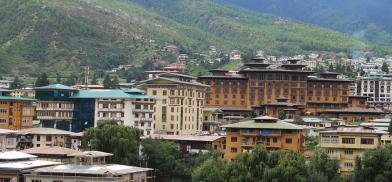Bhutan's GDP growth predicted between 2.2 and 2.9 percent in 2020
The Bhutanese government had just about laid the foundation and set the tone for the rest of its term in office. Then the Covid-19 pandemic came. Now that the focus has been diverted to preventing the spread of the pandemic, the economic outlook for Bhutan has changed drastically

The Bhutanese government had just about laid the foundation and set the tone for the rest of its term in office. Then the Covid-19 pandemic came. Now that the focus has been diverted to preventing the spread of the pandemic, the economic outlook for Bhutan has changed drastically.
In its latest South Asia Economic Focus, Spring 2020, the World Bank estimates that Bhutan’s Real GDP growth in the fiscal year 2020 will decelerate in the range of 2.2 to 2.9 percent depending on how long the pandemic lasts.
Before the pandemic, the country’s growth projection for the year was at 6.5 percent.
The World Bank says that the pandemic will adversely affect agriculture, construction, and export sectors due to disruptions on the supply side such as labour shortages and lower external demand. The trend is likely to continue until the end of 2021.
Growth slowdown in India is expected to dampen external demand, particularly for non-hydro goods and services from Bhutan.
Economic Affairs Minister Loknath Sharma in an earlier interview said that the government was working on minimising the economic impact. Among other measures, the government plans to frontload some of the 12th Plan projects.
The country’s current account deficit is likely to persist given the country’s dependence on essential imports, both for consumption and investment.
According to the report, domestic production of electricity is also likely to decline. Over the medium-term, the external deficit is likely to narrow with the increase in electricity exports from Mangdechhu and Punatsangchhu II.
“Bhutan is a net electricity exporter, but its prices are set with India independently of oil prices. Therefore, it will also gain from lower prices on fuel imports,” the World Bank states.
Other risks that Bhutan faces include possible delays in hydropower project completion and lower-than-expected rainfall, which would negatively impact growth and reduce exports.
The government says it is trying to ensure that the work on hydropower projects is not stalled.
The fiscal deficit is expected to widen to 3.4 percent in the fiscal year 2020 due to a pickup in current spending in response to the Covid-19, and an increase in salaries and wages.
Reduction of the government’s discretionary spending is expected to lead to a decrease in capital expenditure.
According to the report, non-hydro revenues could decline with the slowdown in the services sector. However, hydropower revenues could increase due to the one-off profit transfer from the commissioning of the Mangdechhu hydropower plant.
The World Bank suggests that improvements in tax policy and administration and the implementation of the Goods and Services Tax (GST) will be critical to increase revenues over the medium-term.
“Slower than expected implementation of the GST would also affect fiscal outcomes, because of the discontinuation of excise duty refunds and lower levels of grant financing from India,” the World Bank states.
Poverty reduction, the report says, will continue at a modest pace. The poverty headcount rate at USD 3.20 per day is projected to gradually decline to 9.8 percent in 2020 and 8.8 percent in 2021.
The report predicts that impact of the Covid-19 pandemic on the poverty headcount rate will be modest, as most of the poor work in subsistence agriculture. But some social impacts may materialise primarily through an impact on labour income, the World Bank adds.
Reduced demand for agricultural products could lower export and hurt agribusinesses.
The World Bank says that the risks from weaknesses in the non-banking financial sector, which includes the Royal Insurance Corporation Limited and Bhutan Insurance Limited, remain and need to be monitored.
The World Bank reasons, “The banking sector has adequate cushions to absorb potential losses, given sufficient capital adequacy, but some of the non-bank financial institutions are fragile, particularly in the insurance sector.”
The Non-Performing Loan (NPL) ratio in the financial sector rose to 18.4 percent in September 2019, up from 12.8 percent in September 2018.
Although the public debt in Bhutan is over 100 percent of GDP, this is not a sustainability concern because most of it is contractually linked to hydropower project loans from India. Hydropower output should generate substantial export revenue soon, it says.
The report states that although the current account deficit remains high in Bhutan, its deficit is largely financed by India’s investment in hydroelectric capacity, which should turn into a net income once operational. The report is a product of the Office of the Chief Economist for South Asia Region (SARCE) and the Macroeconomics, Trade and Investment (MTI) Global Practice.
https://kuenselonline.com/gdp-growth-predicted-to-be-between-2-2-and-2-9-percent-in-2020/








Post a Comment